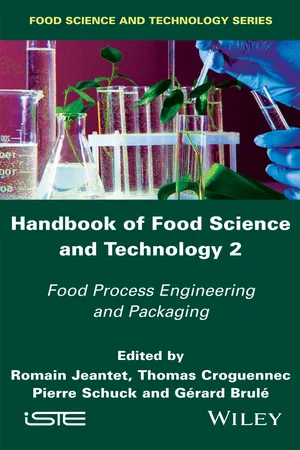
Handbook of Food Science and Technology 2
Food Process Engineering and Packaging
- English
- ePUB (mobile friendly)
- Available on iOS & Android
Handbook of Food Science and Technology 2
Food Process Engineering and Packaging
About This Book
This book is a source of basic and advanced knowledge in food science for students or professionals in the food science sector, but it is also accessible for people interested in the different aspects concerning raw material stabilisation and transformation in food products. It is an updated and translated version of the book "Science des aliments" published in 2006 by Lavoisier. "Science des aliments" is a general and introductory food science and technology handbook, based on the authors' Masters and PhD courses and research experiences. The book is concise, pedagogical and informative and contains numerous illustrations (approximately 500 original figures and tables). In three volumes), it summarizes the main knowledge required for working in food industries as scientists, technical managers or qualified operators. It will also be helpful for the formation of students in food science and biotechnologies (bachelor's and master's degree).
Frequently asked questions
Information
PART 1
Basis of Food Engineering
1
Transport Phenomena – Basis of Unit Operations
- – heat transfers play a major role in the elementary operations of pasteurization, sterilization and concentration;
- – mass transfers mainly govern extraction operations by diffusion.
- – conduction (or diffusion): in this case, the matrix in which heat transfer takes place, can be considered motionless with regard to the direction of transfer. For example, heat transfer in a solid does not involve motion of the material itself. In a liquid, heat transfer may be conductive if the energy is transferred by molecular agitation, apart from the random motion of molecules in the direction of the heat transfer;
- – convection: in this case, transfer processes involve movement of part of a matrix that carries a quantity of heat, mass or momentum from one point to another. F...
Table of contents
- Cover
- Table of Contents
- Title
- Copyright
- Introduction
- PART 1: Basis of Food Engineering
- PART 2: Food Biological Stabilization
- PART 3: Food Physicochemical Stabilization
- PART 4: Food Ingredient Preparation
- PART 5: Packaging
- Bibliography
- List of Authors
- Index
- End User License Agreement